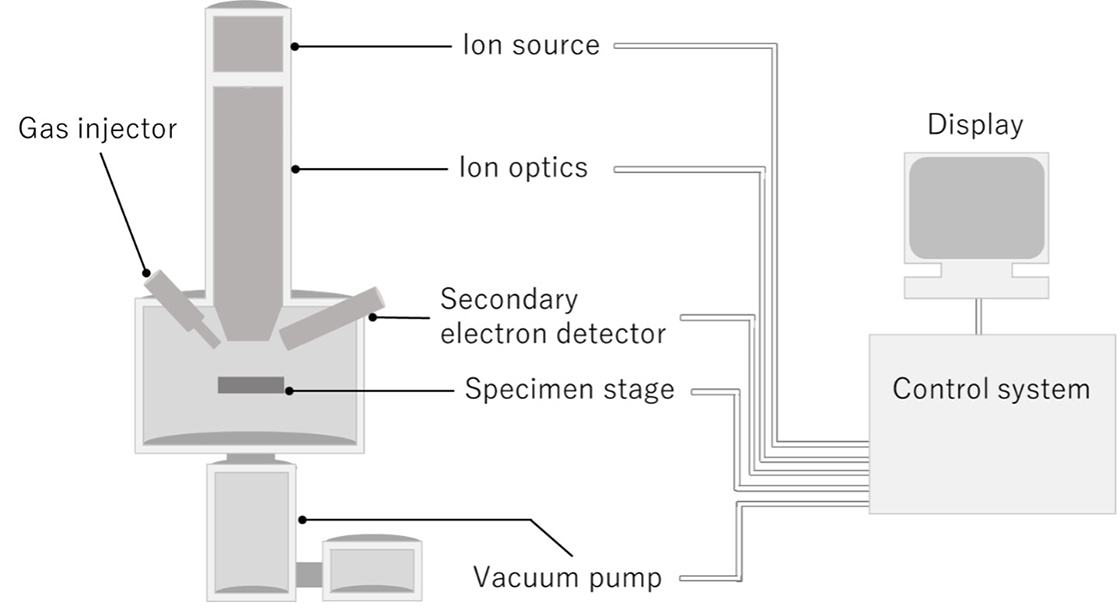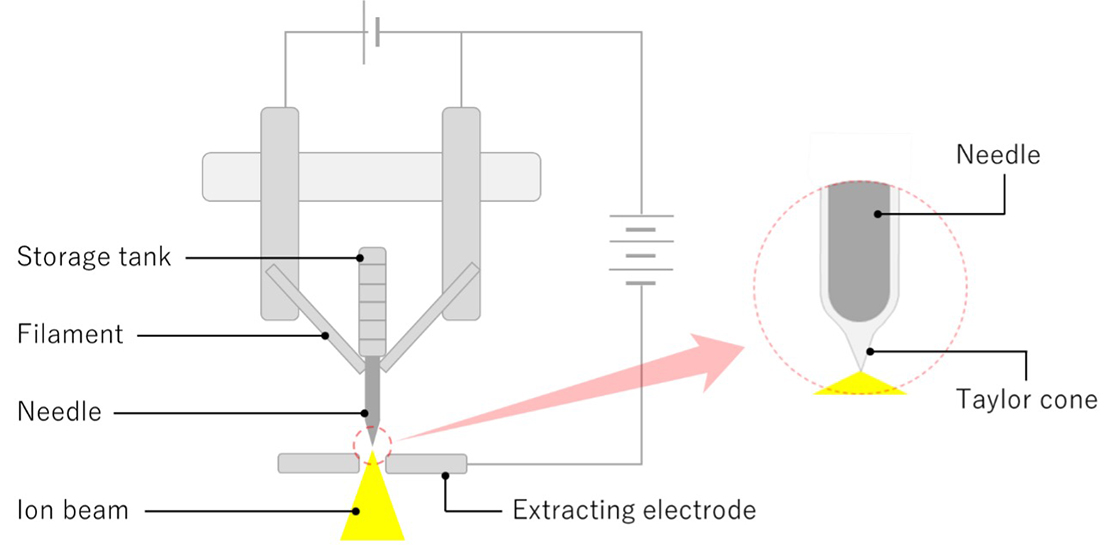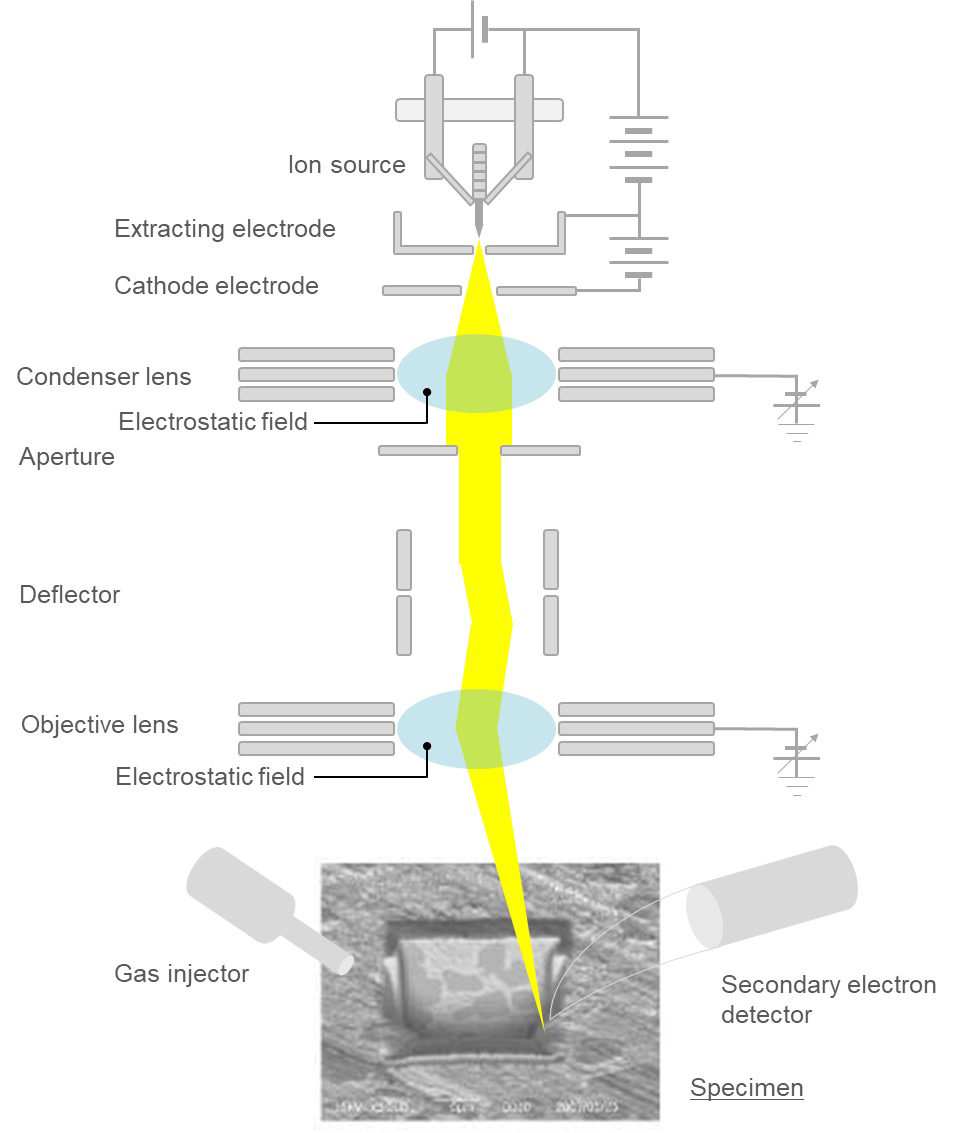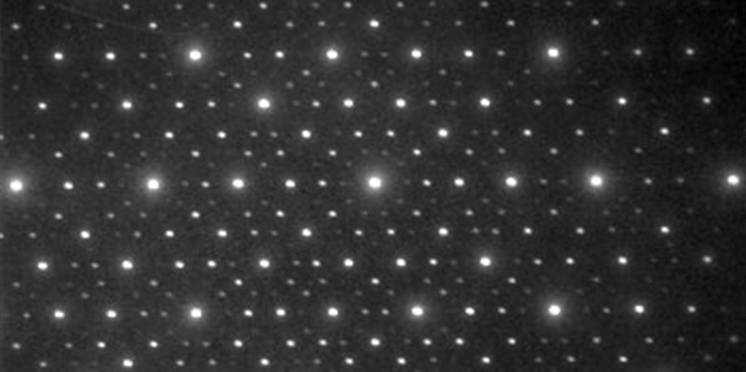focused ion beam system, FIB system
focused ion beam system, FIB system
A focused ion beam system (FIB system) is an instrument to observe and mill a specimen using an ion beam. That is, while observing the specimen surface, local milling and deposition of specific areas of the specimen are performed. The system is applied to specimen preparation for scanning electron microscopy (SEM) and for transmission electron microscopy (TEM), and circuit modification of semiconductor devices, and micro-shape processing of metals, soft materials and biological specimens subjected to fixation.
The basic functions of the FIB system are (1) observation, (2) milling and (3) deposition of the specimen.
(1) Observation: An ion beam is irradiated onto a specimen surface. Using the secondary electrons emitted from the specimen, a Scanning Ion Microscope (SIM) image is observed. The SIM image is more sensitive to the composition and the crystal orientation of the specimen than the Scanning Electron Microscope (SEM) image.
(2) Milling: The ion beam irradiated onto the specimen enters the specimen and sputters the constituent atoms of the specimen (sputtering). By scanning the ion beam onto the specimen, milling of the specific areas is performed.
(3) Deposition: By irradiating an ion beam while spraying organic gas from a gas injector onto the specimen surface, the secondary electrons react with the organic gas to form a local deposition of a film.
The gas sources are mainly carbon compounds (C14H10), tungsten compounds (W(CO)6) and platinum compounds ((CH3C5H4)(CH3)3Pt). Carbon (C) in the gas source is mainly used to protect the specimen surface, tungsten (W) is used to fabricate wiring for semiconductor devices, and platinum (Pt) is used for both applications.
Fig. 1 shows the basic construction of the FIB system. The system is composed of an ion source, ion optical system, secondary electron detector, gas injector, specimen stage, vacuum evacuation system and control system. For the ion source, a liquid metal ion source (LMIS), a gas field ion source (GFIS), or a plasma ion source is used. Among them, LMIS is most-widely used. Gallium (Ga) is the most commonly used ion material for LMIS, because its melting point is close to room temperature (29.7 °C) and its vapor pressure is low (less than 10-6 Pa), which prevents Ga from being consumed by evaporation even in a vacuum. In addition, Ga does not react with tungsten (W), a needle material, and has good wettability.

Fig. 1. FIB-system
Fig. 2 illustrates the construction of the LMIS. By temporarily heating the metal (usually Ga) of the ion source with a filament, the Ga metal in the storage tank melts and wets the tip of the W needle. The liquid Ga at the tip of the needle becomes round by surface tension. When a negative voltage of a few kV is applied to the extracting electrode, a strong electric field is formed at the tip of the needle, and the liquid Ga is attracted by the electric field to form a cone shape (Taylor cone). The electric field is further concentrated at the tip of the cone, and the ionized Ga is emitted.

Fig. 2. Liquid metal ion source (LIMIS) system
Fig. 3 illustrates the ion optical system. The ion beam emitted from the ion source is focused onto the specimen by a two-stage electrostatic lens. That is, the electric current of the ion beam is controlled within several 10 nA to several pA by the condenser lens and the aperture located directly below the ion source, and then, the ion beam passes through the aperture and is focused on the specimen by the objective lens. The focused ion beam is scanned over the specimen by using the deflector electrode, for observation, milling and deposition of the specimen. A high-current ion beam of several 10 nA is used for milling a large area of several 100 µm, while a low-current beam of several pA is used for fine milling of an area of the order of several nm.

Fig. 3. FIB ion optical system.
Term(s) with "focused ion beam system, FIB system" in the description
Are you a medical professional or personnel engaged in medical care?
No
Please be reminded that these pages are not intended to provide the general public with information about the products.




